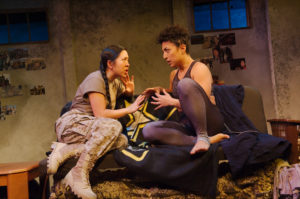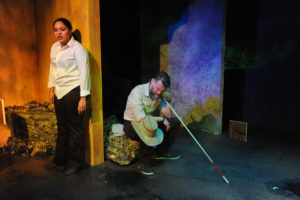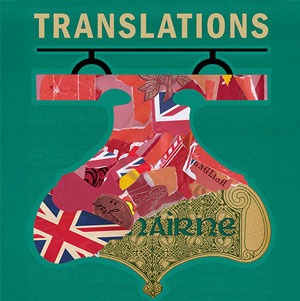
 [rating=3]War is hell! Anyone who has been involved with the current war, or for that mater, Viet Nam ( although we never accepted that one as a war) knows that lives change when one has been in battle. In Kathleen Cahill’s play, “Harbur Gate”, now on that stage of the very intimate 16th Street Theater, we get a glimpse into how one incident can alter the lives of many soldiers. Harbur Gate is the name of the U.S. Base on the Turkish/Iraqi border. The actual name is Khabur Gate, but our G.I.’s decided to Americanize it.
[rating=3]War is hell! Anyone who has been involved with the current war, or for that mater, Viet Nam ( although we never accepted that one as a war) knows that lives change when one has been in battle. In Kathleen Cahill’s play, “Harbur Gate”, now on that stage of the very intimate 16th Street Theater, we get a glimpse into how one incident can alter the lives of many soldiers. Harbur Gate is the name of the U.S. Base on the Turkish/Iraqi border. The actual name is Khabur Gate, but our G.I.’s decided to Americanize it.
What happened in 2004 is revealed through three scenes, not acts that take us from 2005, back to 2004 (the event) and then forward to 2007. The three scenes, played over 90 minutes (no intermission) , will reveal the actions that took place that are on the minds of many soldiers.
The first scene is about two Army medics, who have applied for the Purple Heart played by Arti Ishak and Laurence Stepney. If one watches closely, one can see that these people are not what we would expect as Army medics. But we must also remember that people have changed and they no longer have to hide in the closet. In this scene we also meet, Alyson (deftly handled by Stephanie Shum, who in the second scene shows her true worth), a Marine who we will later see in action in Iraq. During this scene we get hints of what transpired, but the story gets deeper when we go to Iraq.
In this scene, Shum, ( Alyson) is driving in a convoy along with Sgt. Russo ( well-played by Felipe Carrasco) and we bear witness t the events that lead to the awards in the first scene. This is an action packed look at how two Marines facing action look at their lives. It turns out that Alyson is there because another driver, Michelle, was unable to perform her duties. We find out in the third scene the reasons for Michelle to miss and what has taken place in her life as well. It is in a park in 2007. Michelle has just been the cause of an accident and is distraught and nervous. In te park she meets a blind artist, John ( solidly performed by Jay Worthington) who calms her down and allows her to open about why she is as tense as she is. He also was a soldier and suffered at the hands of battle.
“Harbur Gate”, deftly directed by Ann Filmer, is a deep look into the souls of these soldiers and how one incident can affect others. I prefer to leave the details open as to the cause of Michelle’s changing her work schedule as I prefer not to spoil the symmetry and story being told by Cahill. I am sure you will be able to put all the pieces of the puzzle in place along the way.
This play was written after many interviews with women who served, and their stories are what began the process of writing this play. In our new world of war, gender is not treated as it was in previous times, but people, in many cases, still have their prejudices and their fears and hates. This may never be over!
Hats off to Nicholas Schwartz for creating a workable set on this tiny stage. The ability to transform the pieces from apartment to war zone and to the park keeps the action moving and allows the transitions to be done quickly. Tony Churchill’s projections are smooth and the original music and sound by Barry Bennet adds to the overall quality of the production. Jessey Gaffney did a great job with the props and the lighting (Benjamin L. White) allows each scene to play well. Rachel Sypniewski’s costumes are the crowning glory of a solid technical piece.
“Harbur Gate” will continue at The 16th Street Theater located at 6420 West 16th Street in Berwyn through February 17th with performances as follows:
Fridays 7:30 p.m.
Saturdays 4 and 8 p.m.
Tickets range rom $18-$22 and can be purchased by calling 708795-6704 or at www.16thstreettheater.org
To see what others are saying, visit www.theatreinchicago.com, go to Review Round-Up and click at “Harbur Gate”
Street parking is very available, but read the signs on the side streets. There is also a free lot, one block west of the theater.







More Stories
“Henry Johnson”
“Scary Town” reviewed by Frank Meccia
“Translations”